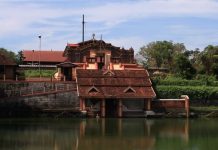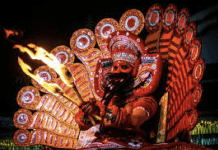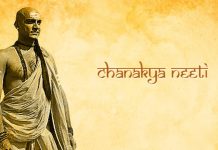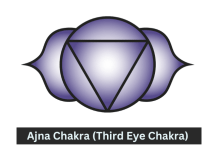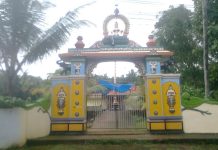Mystical Facts of Thrikodithanam Mahavishnu Temple
Thrikodithanam Mahavishnu Temple is one of the five ancient ‘Pancha-Pandava’ temples in Kerala and is specially associated with Sahadeva, youngest of the five Pandava princes. This temple is also counted among the 108 Temples & Celestial Abodes of Vishnu, which make a Vaishnavite`s pilgrimage itinerary, in India.
View from across the pond
Earliest references to this temple appear in the poems and hymns composed by the greatest of Alvar saints – Nammalvar, in 800 AD. Old stone inscriptions in the temple date it back to the second Chera Empire (800 – 1102 AD). 
The Temple constructed in the Kerala style of architecture, the temple is glorified in the Divya Prabandha, the early medieval Tamil canon of the Azhwar saints from the 6th-9th centuries AD. It is one of the 108 Divyadesam dedicated to Krishna, an avatar of Vishnu, who is worshipped as MahaVishnu. The nearest railway station to the temple is located in Changanassery, while the nearest airport is Nedumbaseri International Airport.
Legend
The Divya Kshetram was built by Sahadeva of Pandavas. King Rukmangatha of Surya Vamsa undertook Ekadasi Vratham and gifted all his punyas to Devas by which he reached Devaloka. There are also shrines for Krishna and Narasimha.
Another legend is that temple servant being cursed by the deity to turn into a stone as he delayed the opening of the temple doors making the devotees to wait for Darshan. The statue of the servant can be seen in front of the temple. A monthly Sravana Deepams (festival of light) is performed.
Sthalapuranam : This sthalam is said to be worshipped and constructed by Sahadevan, one among the Pandavas. This sthala perumal, Athpudha Narayanan gave his seva (prathyaksham) for Rukmaangadhan, who is one of the king of Soorya Vamsam (generation). He had a great thought for the world people and worked for their life. He greeted all the Gnanis, Yogis and bhaktaas of Vishnu and gave them proper respect and satisfied their needs. On hearing this, Vasishta Maharishi told about the great character of Rukmaangadhan to Indiran.
To test the great character, Indran send Naradhar to Rukmaangadhan. Rukmaangadhan welcomed Naradhar and gave him lots of respect by doing Padha poojas and offered him with a special garland which had a peculiar flowers in that. Naradha getting the proper respect from him, left that place. By blessing him. Naradha went to Indra lokam with the garland that is given by Rukmaangadham. On seeing the beauty and the smell that came out from the flower, Indran was very much attracted by it and ordered his soldiers to get the flower from the Garden of Rukmaangadhan.
As ordered by Indra, the soldiers daily stole the flowers from the Garden and gave it to Indran. Rukmaangadhan was surprised to see the flowers being plucked and placed some soldiers to check who is stealing the flowers. But, the deva loka soldiers, without being seen by the soldiers placed in garden, stole the flowers.
The garden soldiers fired some garlic plants to get the light, so that using the light, they can easily catch the person who is stealing the flowers. The smell of Garlic is said to have the character of minimizing the Power of Gods. At this stage, the smoke of that came out of the Garlic plants mixed with the air and all the soldiers of Indran lost their powers and the soldiers in the garden also lost their power and as a result, they were caught and finally they said that they belong to Indra lokam and explained all the things.
On hearing this, Rukmaangadhan didn’t get angry, instead gave them proper respect and treated them well. But, Simultaneously all the soldiers, Devars in Deva lokam lost their power and that day is said to Ekadasi day. All of them asked at least minimum amount of credit from the person who is doing fasting on Ekadasi. Rukmaangadhan searched for a person who is fasting on Ekadasi. But, he could not identify not even a single one.
Finally, a women who led her life by washing clothes of the village peoples fought with her husband and because of this, she didn’t have her food for the day. Without knowing the day is Ekadesi, she did the fasting. He explained all the things to her and asked her to give the credit of the viradham, there by helping the devas of Deva lokam. She also accepted it and gave one part of her vradham to them and to regain their power. Rukmaangadhan thanked the women and gave lots of precious ornaments and money to her. Thus, through Rukmaangadhan, Sriman Narayanan explains the greatness of Ekadesi Viradham.
Architecture
The Moolavar found in this sthalam is Athpudha Narayanan. He is also named as ‘Amirutha Narayanan’. And he is in Nindra Thirukkolam facing the east direction. Prathyaksham for Rukmaangadhan.

Thayaar: The Thaayar of this sthalam is Karpagavalli.
Mangalasasanam: Nammalwar – 11 Paasurams. Total 11.
Pushkarani: Bhoomi Theertham.
Vimanam: Punniya koti Vimaanam.
Kazhuvetti Kallu – The strange statue outside
Between the pond and the eastern entrance, near a public platform for arts and discourses, is a strange granite statue. It is a man flat on his back, held up stiff and straight on a stone pillar about six feet high. 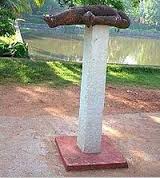 Only his waist rests on the pillar, rest of the body is unsupported. He holds a shankhu (conch shell) in his left hand and wears the sacred thread indicative of the brahmin castes. At one time the statue wore a crown as well. The idol is a stern reminder that bribery, cheating and dishonesty cannot be tolerated. Anybody who goes after these evils will be met with the capital punishment, such as, that met with the man lying on the stone.
Only his waist rests on the pillar, rest of the body is unsupported. He holds a shankhu (conch shell) in his left hand and wears the sacred thread indicative of the brahmin castes. At one time the statue wore a crown as well. The idol is a stern reminder that bribery, cheating and dishonesty cannot be tolerated. Anybody who goes after these evils will be met with the capital punishment, such as, that met with the man lying on the stone.
Common folklore about this stone idol has a story of jealousy, indiscretion and swift retribution.
The ruler of Chembakaserry kingdom was a renowned Nambuthiri Brahmin who took pride in the prosperity of his own kingdom and Sri Krishna temple. Since temples were then considered keystones to a kingdom’s spiritual and temporal well-being, the King decided to embarrass the rulers of Nanrulainattu (capital-Thrikodithanam) by making a deliberate, untimely visit to the famous Vishnu Temple. He arrived in Thrikodithanam after the Seiveli puja (the last ceremony of the day) and after the temple had closed. It is considered very inauspicious to open a temple after the gods are put to rest, but still, the King forced an entry by bribing a caretaker. When the rulers of Nanrulainattu discovered this indiscretion, they were furious. The caretaker was beheaded and, soon, the Chambakaserry king too fell ill and died. So this stone figure was installed near the temple entrance to deter any future offenders and to remind everybody of the consequences of disturbing the gods.
Another version of the story lays the blame on the king of Ambalapuzha for this surreptitious Darshan.
Traditions, Rituals & Festivals
DAILY PUJAS & CEREMONIES
The following Pujas are performed everyday by the Shantis – temple priests:
- Palliunarthal : 7.5 naazhikas (3hours) before sunrise
- Abhiseka : 1.25 naazhikas (30 minutes) before sunrise
- Usha-puja: 25 naazhikas (30 minutes) before sunrise
- Ethrtth-puja : Between 2.5 naazhikas (1 hour) and 2.75 naazhikas (1.5 hours) after sunrise
- Pantheerati-puja : Between 5 naazhikas (2 hours) and 6.25 naazhikas (2.5 hours) after sunrise
- Navaka-kalabhisekam : 7.5 naazhikas (3 hours) after sunrise
- Uccha-puja : Between 11.25 naazhikas (4.5 hours) and 15 naazhikas (6 hours) after sunrise
- Thirija-pantheerati : 5 naazhikas (2 hours) before sunset
- Attazha-puja : Between 2.5 naazhikas (1 hour) and 5 naazhikas (2 hours) after sunset
MONTHLY PUJAS
- Ekaadashi & Dwaadashi : 11th and 12th day of the lunar-month; the day Sri Krishna gave Geethopadesha to Arjuna
- Pradosham : 13th day of a lunar fortnight; a day of fasting and praying to Shiva; the day Shiva appeared as Nataraja and danced to please the gods.
- Chaturthi : Fourth day of a fortnight; dedicated to Ganapathi to help ward off obstacles.
- Sashti : 6th day of a full moon fortnight; dedicated to Subramanya for progeny and prosperity
- Ashtami : Special rituals for Vishnu and Shiva
- Pournami : The full moon night
ANNUAL FESTVALS AND EVENTS
The main festival of 10 days duration takes place in the lunar month of Vrishchigom (16 November- 15 December). On the ninth day – Thiru-Onam – of this holy month, the temple flag is hoisted to mark the commencement of festivities.
The first five days of festivities are much like temple festivals elsewhere. Daily processions carry Krishna and Sahadeva idols towards East, West, North and South of the temple. But the sixth day marks the start of many events that are special and unique to Thrikodithanam temple.
Ceremonies and performing arts that mark the festival season are:
Plaam-keeyil-kottu : Percussion session under the old Jackfruit tree
Panacchikaletta : This event, marking the start of Deepa, begins at around 1:00 AM on the 10th night. South of the temple, at a spot called Edapzhanji-padikkal, an orchestra plays the Vikku-chenda, Thimila, Chekkil, Ilathaalam for more than an hour. The musicians then proceed westwards.(Legend: This event commemorates the grand reception given to a victorious military commander called PAAZHAYIL ASHAAN. He is welcomed by the citizens of Thrikodithanam with drums and cymbals and is ceremonially taken out to witness the DEEPA. This hero too is consecrated along with Manikanthan (Ayyappa), at the Sastha shrine.)
Chhadi-kottu : After Panacchikaletta, the orchestra reaches the western entrance of the temple. After offering prayers to Narasimhamoorthy, they then use the same musical instruments to perform Chaadikottu. As the term indicates, in this performance, the drummers leap and jump in a certain way while while moving towards the eastern entrance and Deepa site
Otta-kol-kottu : By drumming with a single stick on the Vikku-chenda, the performers create a unique cadence. After this, between 2:00 AM and 3:00 AM, the main ceremonies for Deepa commence.
Murian-kulam : Ceremonial baths in the temple pond.
Kodi-naatin-kunnu : Hoisting a flag on an adjacent hill.
THE SPECTACULAR DEEPA
This special event is conducted on the north-eastern side of the temple Thirumuttom (grounds). It commences after dusk on the 9th Festival Day and carries on until the early hours of 10th day morning.
The centrepiece of this event is a pyramidal structure called the Shara-koodam (Arrow-heap). To make this structure, pillars are fabricated from plantain stems kulavaazha and bound by strands of the arecanut palm to form the square base. Then small frames are made atop this base by tying together wood splinters. Once the base structure and the small frames are ready, 1001 flares made of cloth bundles dipped in oil are placed on a structure called the sankaetam.
After a special percussion session (Panachickaletam and Chadikkottu), this entire pyramidal structure is set alight when the final evening prayer procession – Seiveli pooja – passes that way. The huge framework of 1001 flaming ‘arrows’ presents a grand sight.
This entire event is supposed to mark Sahadeva’s reaction when he hears of the demise of his mother, Madri. Overcome with despair, he tries to jump into her funeral pyre. This drama too is re-enacted every year by the Brahmins of the Mecheril Illom.
Then there is a sudden end to festivities on the hill – lamps are doused, elephants are sent back and the priests go home after taking a final ritual bath in Muriankulam . People then collect the ashes of the fire as prasaadam and depart.
Ashtami-Rohini : Sri Krishna`s birthday is also an important festival day at Thrikodithanam Temple.
See Temple’s Kazcha Sreebali;
How to Reach Thrikodithanam Mahavishnu Temple
Thrikodithanam village is located on the outskirts of Changanaserry Municipality in Kottayam District, Kerala, India.
A Gramam or village occupying an area of 9.5 sq.KM, it has population of approx. 45,000. The local administrative body is called the Panchayat . Other Panchayats adjoining Thrikodithanam are Paippad and Kunnunthanam.
By Road – The temple is on the Changanaserry-Kaviyur Road. It is 2.5 KM from Changanaserry town.
By Rail – Changanaserry Railway Station is 2 KM away.
By Air – Nearest International / Domestic airport is at Kochi, ~ 100 KM away.
Google Maps – Location of Thrikodithanam Temple on Google Maps here.



